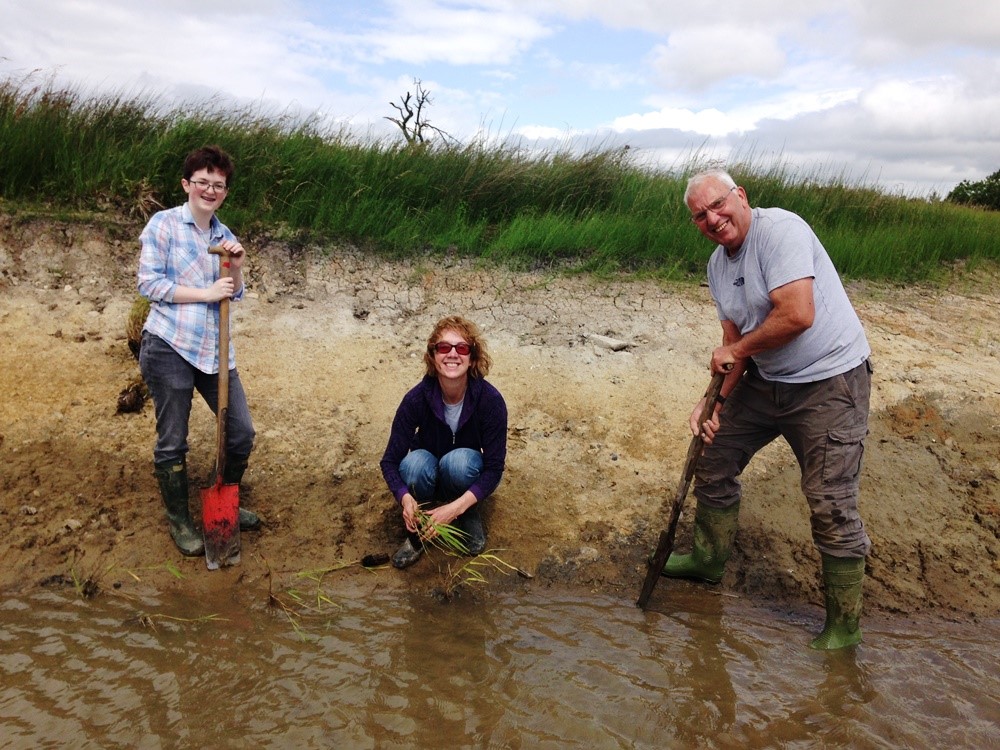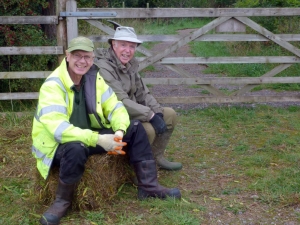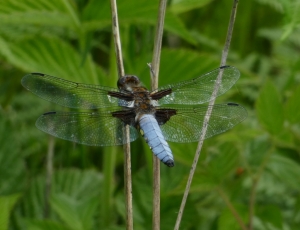Blog Archive (22) Posts Made in August 2013
Wildlife Garden
Thursday, August 29th 2013
From time to time wildlife ponds in gardens need clearing out to stop some of the more vigorous water plants from taking over. The pond in the back garden has been overlooked for some time now and was dense with vegetation; there was not one place on the surface where you could see water.
Work began to thin out some of these plants but it soon became clear that there was a thick mat of interlocking roots going right to the bottom of the pond; it was an all or nothing job. By lunchtime a huge amount of debris had been pulled and cut out of the little pond.
David and Garth then spent the afternoon re-landscaping the edges of the pond where roots had grown and pushed rocks around. The finished product looks fantastic and with a rain shower or two will soon be full again allowing plants to thrive.
Once re-vegetated the pond will once again become a haven for wildlife. The shallow areas will be covered with pebbles and provide shelter for small invertebrates and snails; plants around the margins will provide shelter for amphibians such as the Great Crested Newt which is regularly seen on the reserve. A large number of invertebrates will also be attracted to the pond and surrounding plants to feed which in turn can provide a food source for birds as well as a place for them to bathe and collect moss for nesting material.
Thank you for your help on this project and watch this space for more wildlife friendly ideas you can try in your own garden!
Rivers of the North and South Quiz Answers
Wednesday, August 28th 2013
Thank you again to Glennis and Pat for writing the quiz for us. This edition has raised in excess of £150 for the reserve, the answers are listed below.
Rivers of the North
- It doesn't flow through Wales - Swale
- It grew by Camelot - Rye
- Did it flow through the first garden? - Eden
- A different name in days of yore - Ure
- Named after Garbo - Greta
- Basil Bunting wrote of it - Rawthey
- Could this be a flirtatious man? - Coquet
- The river must Do Little out east - Liza
- The bird of peace - Dove
- It underwent a change - Derwent
- Sounds as though it erodes its banks - Wear
- Tee off to the South - Tees
- Eric catapulted inside this river - Riccat
- It was oddly greylot - Gelt
- Bradman or duck? - Don
- Enid didn't care to hide it - Nidd
- Ask Ernest where the river is - Skerne
- Rock the cradle - Calder
- Sounds like it is good for beating eggs - Wiske
- Sounds very breathable - Aire
Rivers of the South
- Without right it is a number - Severn
- Sounds as if it seeps into everything - Ouse
- Smoke it or ride it - Camel
- It makes good butter - Churn
- Go fishing with a broken net - Kennet
- Does this flow quickly - Fleet
- Shakespeare knew this river - Avon
- A quick exam - Test
- It alters tours - Stour
- The easiest of all is included here - Fal
- It's a permenant spot on the skin - Mole
- 'e wishes to 'eat the water - Otter
- Chops the wood - Axe
- He's exempt inside here - Exe
- Does it flow to the West? - Frome
- No 'bravo' for my brother - Rother
- It was formed way down in Kent - Medway
- Give Kath a message from inside - Thames
- Do things breed by this river? - Brede
- It got mixed up in a mart - Tamar
The top five scores were:
- Christine Byers - 39/40
- Michael Fenwick - 39/40
- Viv Winter - 36/40
- Paul and Elaine Thorpe - 36/40
- Tim Helps - 35/40
With two people sharing the top score of 39/40 Christine Byers name was drawn out of a hat as the winner and will receive a £10 prize.
Pond Maintenance
Tuesday, August 27th 2013
The ponds on the wetland have become choked with thick vegetation this summer leaving virtually no open water for wildfowl and wading birds. Volunteers spent time today working in glorious sunshine to clear some of this away. You can see from this 'before' picture how thick the rushes and reeds had become.

By lunchtime everyone had worked up a healthy appetite as the first pond had almost been cleared. After lunch work started on a second pond; by the end of the day this too was finished. The plants we have removed have been left on the banks to drain and allow any invertebrates to find their way back into the water before they are cleared off site.

Thanks to everyone for getting stuck in and working so hard today, I hope your wellies will have dried out in time for next week!
A Sunny Day!
Tuesday, August 27th 2013
Last night the weather forecast for today was studied and the wind had dropped! Ideal conditions for ringing Mipits (Meadow Pipits) at The Crater. 0600 saw the bird ringers setting out the nets. It was still and not too cold although Foxglove was covered in a light mist. As the dawn broke so the the Mipits could be seen flocking over the moor. Swallows joined in too. The sun broke through, the mist cleared and the temperature rose and it was still. No hats, scarves, gloves or coats in sight! There are not many days like this at The Crater.

Net rounds saw many birds being brought to the ringing station and by the time the nets were taken down over 150 new birds had been processed. Very rarely do we catch a juvenile bird that we have ringed earlier. They fly in, feed and leave, so each time we visit there are new birds to be ringed. This year over 250 have been ringed so far and not one has been caught twice! Thank you to everyone who helped this morning.
Leaving the moor to return to Foxglove, a Buzzard was spotted trying to hide and rest in a tree with very few leaves, but it was being glowered at by three Rooks. It took flight and some photographs were taken against a blue sky. It would be nice to think that these are 'our' Buzzards that were ringed earlier in the year.

Weather is important for our flora and fauna and today, in the sun and warmth, it was the turn of the butterflies to show their beautiful colours. Peacock butterflies were again flying in great numbers feeding from many different flowers, although Hemp Agrimony appeared to be their favourite. Looking carefully, Small Tortoiseshell, Red Admiral and Comma could also be seen. This Comma below, responded to being asked to open its wings!
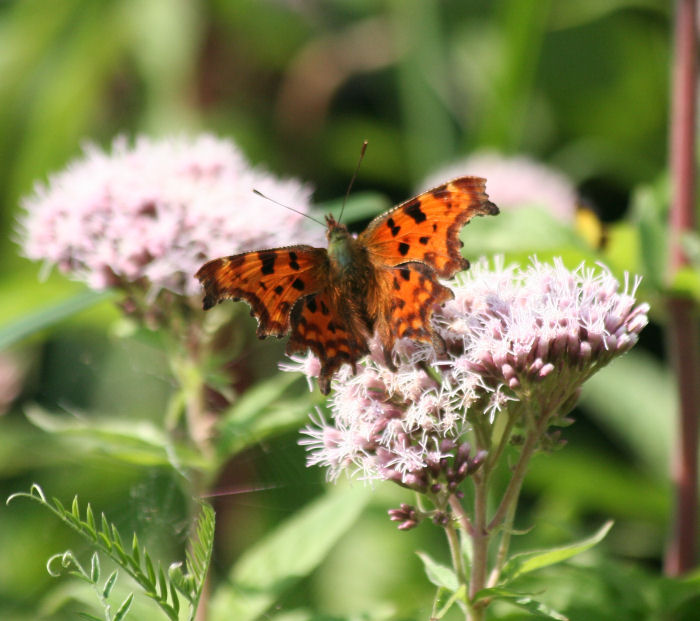
During the butterfly surveys so far this year, Speckled Wood have not been recorded in large numbers. Over the last couple of weeks that has changed and they can now be seen all over the reserve. They too were enjoying the nectar of Hemp Agrimony.

Many visitors enjoyed the sunshine and a reporting of two Water Voles in different ponds through the Scrapes was very pleasing. We normally only record that apple put out for them has disappeared, and there are plenty of fresh droppings on the mink raft! Fish were jumping in the Lake making rings on the smooth surface of the water. Darters were sitting in the sun and the light was causing their wings to look bronze. Dragonflies were hawking across the ponds. Emerald Damselflies are still on the wing. Bees, wasps and hoverflies were making the most of the warmth and feeding from the late summer flowers. Toads and frogs, nor long having left their ponds, are walking and jumping through the undergrowth.
Sunbathing Darters
Sunday, August 25th 2013
Darters appear as soon as the sun comes out. They sunbathe. With so much vegetation around, all shapes, sizes and colours, you would think this would be ideal for them, but no they prefer the man made structures.
This one was extremely co-operative sitting on the rail of a bridge, as we photograhed her (?) very close up. She could see us and the camera, but stayed put for a little while.
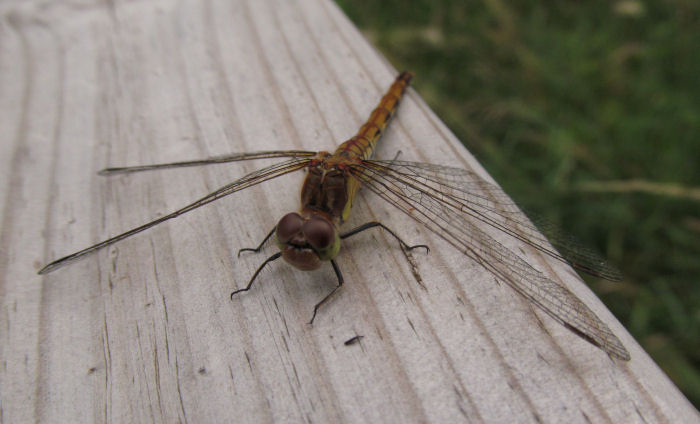
The seats around the reserve are not just for people, darters like them too! We counted at least a dozen of them flying around and then resting on this seat.
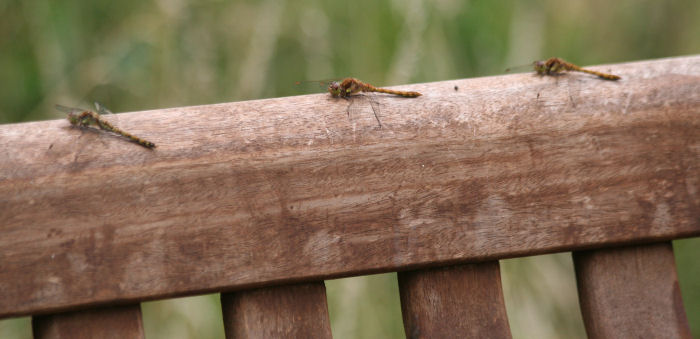
All of the net rides are labelled with red markers and are important especially during CES, but they have another use. Perched in the sunshine, this darter was enjoying her (?) catch.

Herbie the Hawkmoth
Friday, August 23rd 2013
John and Jean popped in this afternoon with a caterpillar side-kick for us to identify. Their find has been identified as an Elephant Hawkmoth caterpillar, named Herbie.

Elephant Hawk-moths are quite often seen in the moth trap over the summer months; the caterpillars can be seen from July to September. Like most hawk-moth caterpillars there is a backward curving spine on the final abdominal segment. The front of the caterpillar appears to have the shape of a trunk like snout - it is this that gives the moth its name rather than its large size. The preferred foods are Willowherbs and Bedstraws. Herbie will pupate over the next few weeks in a flimsy cocoon formed among plant debris on or just below the ground before emerging as and adult early in the summer.
.jpg)
Richmond Coffee Morning
Thursday, August 22nd 2013
Today was the second of our coffee mornings this year at Richmond Town Hall. Several volunteers turned out to help us fundraise at this busy event.

Glennis and Joan spent time welcoming people and taking payment.

Coffee and Tea were poured out and delivered to tables by Tony and Howard.

Behind the scenes Colin, Sue and Jacky managed to keep up with the washing up as the crowds came in.

Many people had spent time earlier in the week baking for Rachel's cake stall, or had brought items in for the tombola all of which helped us to raise a fantastic £161.70! Thank you everyone who has spent time baking, making coffee, washing up, greeting people, and running the stalls; and of course a big thank you to Elizabeth who looked after the reserve while we were enjoying a coffee out this morning!
Bioblitz - The Results!
Wednesday, August 21st 2013
Almost a month ago Foxglove hosted its very first Bioblitz event, in essence a race to discover and identify as many species as possible over the weekend. A team of naturalists had been recruited to lead walks and surveys for volunteers and visitors looking at a huge variety of flora and fauna. In addition to this, Foxglove was host to a Heritage Skills weekend, with local artisan craftsmen demonstrating their skills and encouraging everyone to get involved.
The success of the demonstrations, walks and surveys were all dependant on several factors, not least the dreaded British weather; the two weeks prior had been wall to wall sun with temperatures to match. We were lucky over the weekend experiencing some sun and warm temperatures, excellent conditions for seeing many of the different animal species that make their home here at Foxglove.
.jpg)
After a warm still night, the weekend kicked off with the moth morning producing a record number of moths. Exactly 200 species were identified, with over 2,200 individual moths in the traps! Fifty three of these were new to the reserve taking the total number of moth species recorded at Foxglove to 475 species.
Other walks and surveys over the weekend included a bird walk where visitors were lucky enough to hear and see a Grasshopper Warbler. The fungal foray turned up some Dog Stinkhorn which was deemed edible despite the name; this was then cooked on the BBQ and tasted by a brave few. One of the highlights of the bat walk, late on Saturday evening was hearing Nightjar ‘churring’ – a very special observation as the species not been heard here since 2007. A juvenile bird has since been caught and ringed on one of the CES ringing days.
For many of the children who attended the rope making stall, run by Norman Bush, was a firm favourite. Many hours were spent learning the skill of lassoing out on the front lawn. Coracles, traditional Welsh fishing boats, could be seen at times over the weekend bobbing about on the lake, while the Foxglove Bodgers had set up pole lathes in the car park to demonstrate and pass on their newly learned skills.
The weekend also saw visits from the Yorkshire Fern Group, The Yorkshire Branch of the British Dragonfly Society, and the Leyburn Dry Stone Walling Association. Tim Helps kindly put his fabulous butterfly collection on display; these specimens show examples of species found across the globe. The accompanying stories were equally as fascinating as the butterflies themselves!

The surveys uncovered a huge range of species, with many new species for the reserve being recorded. With records still coming into us it will no doubt be Christmas before we have the final total; as it stands now the total number of species recorded is 623 with the list broken down as follows:
Species Totals:
Amphibians – 5
Birds – 46
Butterflies – 12
Dragonflies – 8
Ferns – 12
Flowers – 99
Fungi – 26
Other Invertebrates – 96
Lichens – 50
Mammals – 15
Moths – 200
Other Plants – 3
Trees – 51
Total: 623
Of course, all of this would not have been possible without the team of naturalists, craftsmen, volunteers and cadets. We simply don't have space to mention everyone who was involved, however, we are extremely grateful to you all for the time and effort that you put into the weekend making it such a huge success.
Team Tuesday
Tuesday, August 20th 2013
Team Tuesday were hard at work yet again working to improve areas of the reserve. The ‘Dambusters’ can be seen here taking a well-earned break after repairing the last of the dams at the Vole Ponds.
The grass under one of the orchard areas was cut yesterday and raked off by volunteers early this morning. This is managed in a similar way to a wildflower meadow, removing the cuttings helps to reduce the cover of coarse grasses and rushes while encouraging a diverse ground flora to develop. This then provides a food source through the summer after the early blossoms on the fruit trees.
Martin and Conner along with the other volunteers spent most of the day on the moorland cutting back Bracken. It is noticeable that due to the cutting regime over the last few years the Bracken cover has been reduced here significantly.
Thank you once again for all of the hard work and time you put into Foxglove!
Close Encounters
Monday, August 19th 2013
Yesterday morning Brian was walking around the reserve when he had a close encounter with two Roe Deer. By the time it took for the camera to come out, the doe had walked off, but the buck continued on his way towards Brian. A magnificent buck in good condition, with his antlers full grown and out of velvet. The rutting season is approaching and we suspect he was keeping a close eye on the doe.

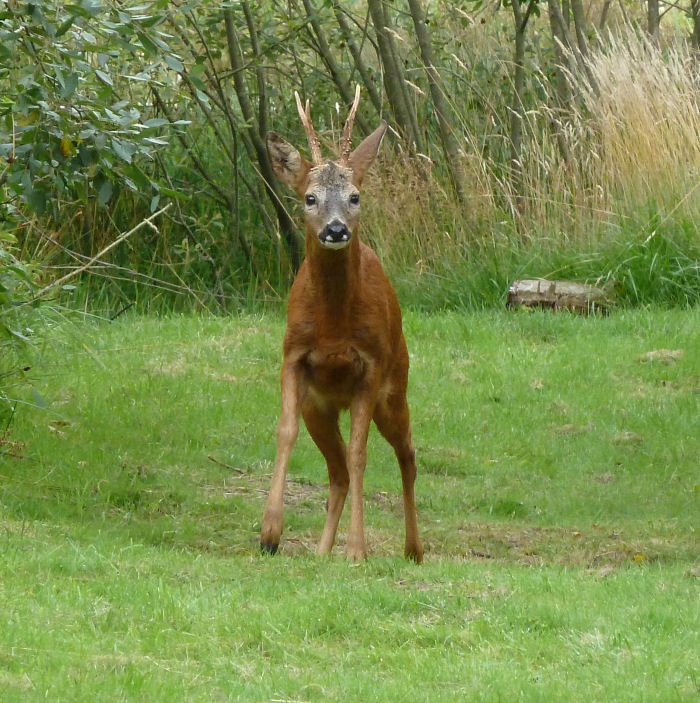
CES 11 had another close encounter. Over the last month Nightjar have been heard in different places around the reserve. Today one was caught in a mist net in the willow carr. They are more likely to be associated with heathland, although can be found on moorland, in woodland or coastal sand dunes. It was a juvenile, so we are hoping that they have bred on the reserve. During the day they lie motionless on the ground and are very well camouflaged amongst dead vegetation. Dusk is usually the best time to see them flying. Waving a white handkerchief around attracts them. In the early years of ringing at Foxglove, white material was tied to the net to lure them in. They also came to a tape lure and flew around the old ringing hut, now the seed store. This is only the third Nightjar ringed at Foxglove, the previous two were ringed in 2002!
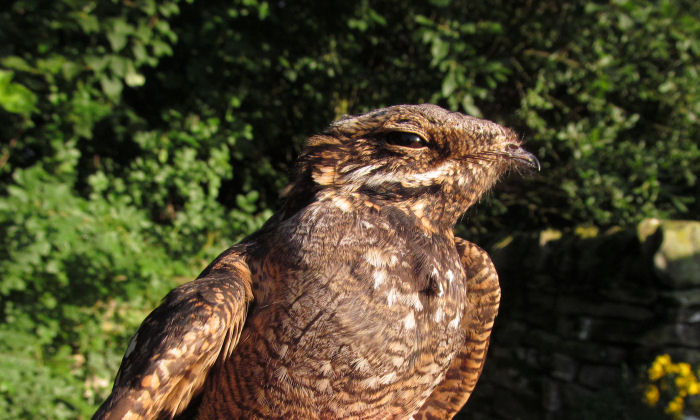
In close up you can see hairs at the side of the beak. These are used to help them catch flying insects. Their gape is very large!

This weekend members of The Army Ornithological Society (AOS) visited Foxglove. They ringed Meadow Pipits at the Crater on Saturday morning and helped with CES today.
.jpg)
Over 180 birds were processed. Fewer Willow Warblers were ringed than in recent weeks, as many have already started their journey south. Six Jays were seen together in the back garden this week and two, making their unmistakeable cry, were ringed today. Several new Wrens also left the ringing room sporting their new rings.
Many thanks to everyone, including the AOS, who helped throughout the weekend.
The Hard Work Pays Off
Friday, August 16th 2013
Late summer is one of the best times to visit the reserve. With almost 100 species of plant in flower the colours are incredible. Especially so on the heathland where the heather is out in full bloom.
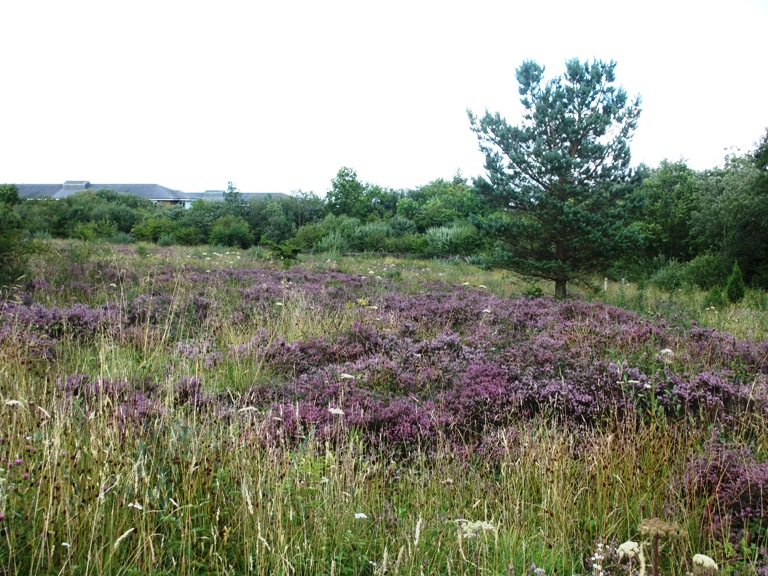
Everywhere, the results of the winters toil is evident. Earlier this year staff and volunteers cut a section of the reedbed to encourage new growth.
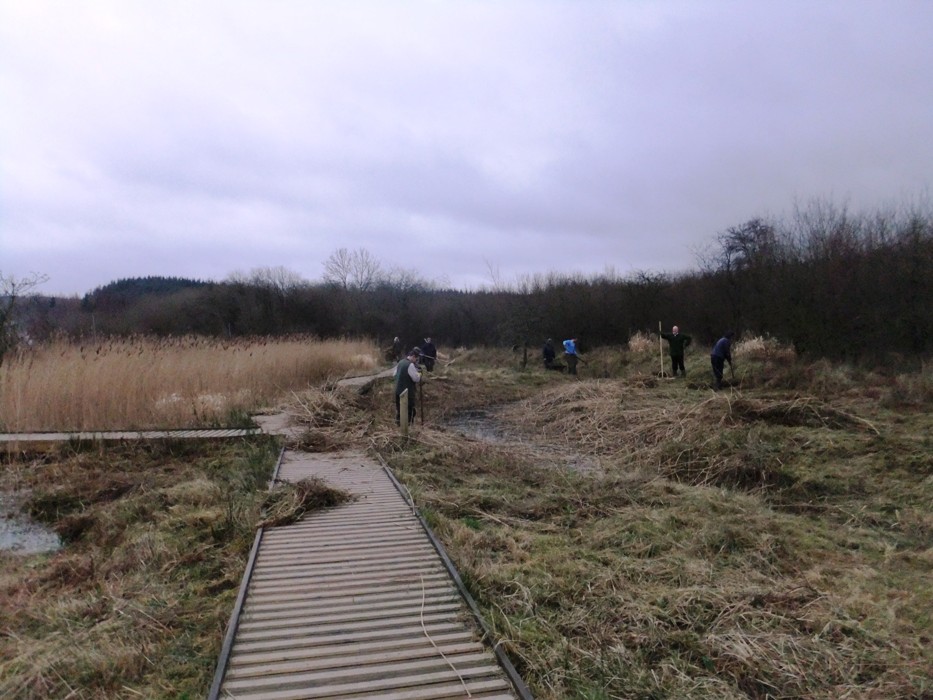
As can be seen below, this was a huge success and as a result Sedge Warblers were able to breed here this year.
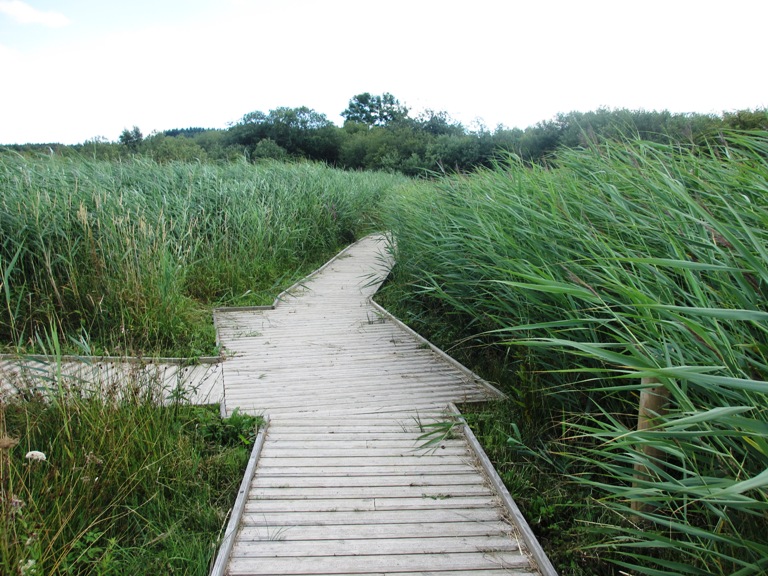
Another habitat that has been improved greatly is an area of willow that was coppiced over the winter months.

The willow has recovered well and this summer has seen perfect conditions for the new growth. Willow Warbler, Chiffchaff and Robin have all been observed here along with hundreds of dragonflies and butterflies making all of the hard work worthwhile.
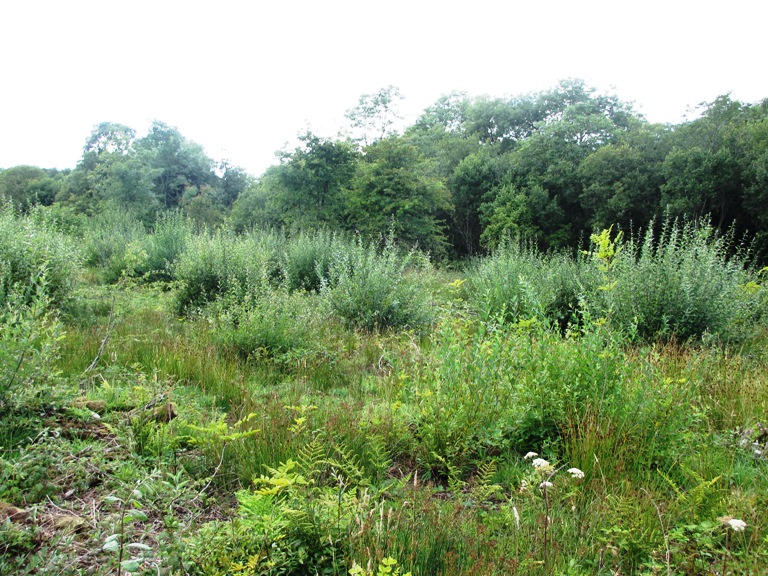
Summer Work
Thursday, August 15th 2013
Volunteers have been hard at work over the past few days toiling away on many of the jobs that crop up around the reserve during the summer. Mike and Tony spent time replacing and repairing some of the nestboxes that have seen better days.
The birds certainly will be pleased with the new roofs and weather proofing that have been installed.
Others have been clearing areas of Bracken from around the lake and along Risedale Beck. This invasive plant smothers any other ground flora (apart from Stinging Nettles, as the volunteers will no doubt tell you!) so clearing it is vital if we are to maintain a diverse range of wild flowers in these areas. As well as the work outside Jacky spent her morning pricing all the books for sale in the Field Centre to help avoid confusion when purchasing. Thank you all for the hard work you have put in this week.
It is time again for the Richmond Coffee Morning one week today. If anyone could help us by baking a cake or two to sell we would be very grateful - they can be dropped off in the Field Centre next Wednesday or at the Coffee Morning on Thursday.
From Dawn till 5
Thursday, August 15th 2013
Dawn was breaking as the bird ringers met at 6am to head to the Crater, out on the MOD training area.

From here Teesside can be seen.

It is not often that the weather is just right for ringing at such a height and conditions can deteriorate very quickly. This morning it was just perfect! At this time of year juvenile Meadow Pipits (we call them Mipits!) flock to the area to feed before heading south. It is noticeable that there is a range in their wing size and weight. Some are obviously quite young and still have some growing to do.
As this one was being photographed he looked up, as other birds were flying over and calling. He was quickly released to join them.
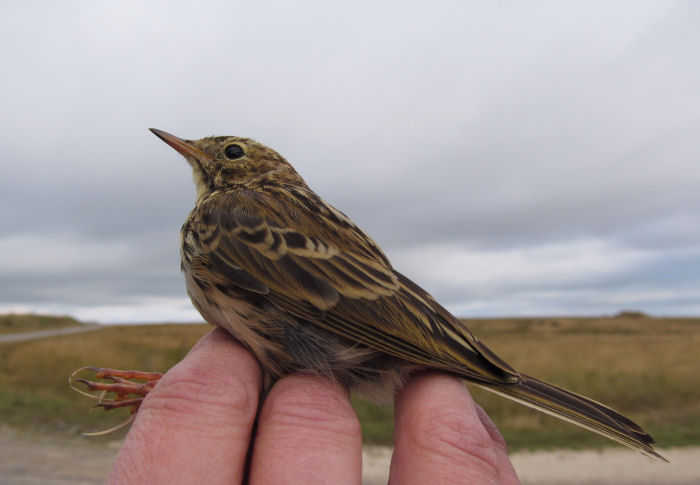
The ringing room at Foxglove has excellent facillities for bird ringing. Out on the moor some DIY has to be employed and the Landrover became an integral part for Sophie's hooks, on which to hang the bird bags.

Over 100 Mipits were ringed today and a Willow Warbler and Swallow were caught too.
.jpg)
Overnight at Foxglove the moth trap.had been set along one of the paths. A good place to catch moths! Over 100 moths of 30 species were caught. It was a marathon task to identify all these moths.
There were many beautifully marked and coloured moths in the trap and when released some sat very still, so photographs could be taken. This Swallow Prominent moth has lovely markings but when looked at head on he is furry, he even has furry legs!

Whilst having a break from checking dots and lines, square spots and round spots, the identifying team found yet another moth!
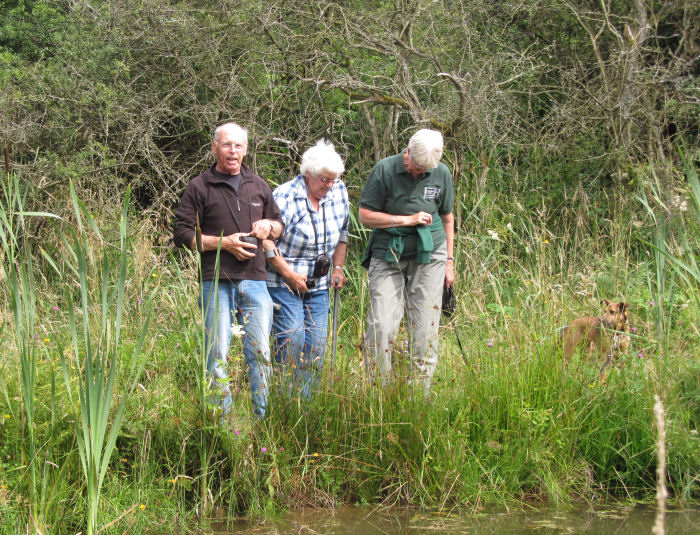
Peacock Butterflies put on a show for the many visitors who enjoyed walking around the reserve today. There were many sightings reported back, but Kingfisher, Buzzard and Water Vole were the highlights.
Later in the day this Speckled Wood was caught in the sunshine.

And finally a grasshopper who sat still!
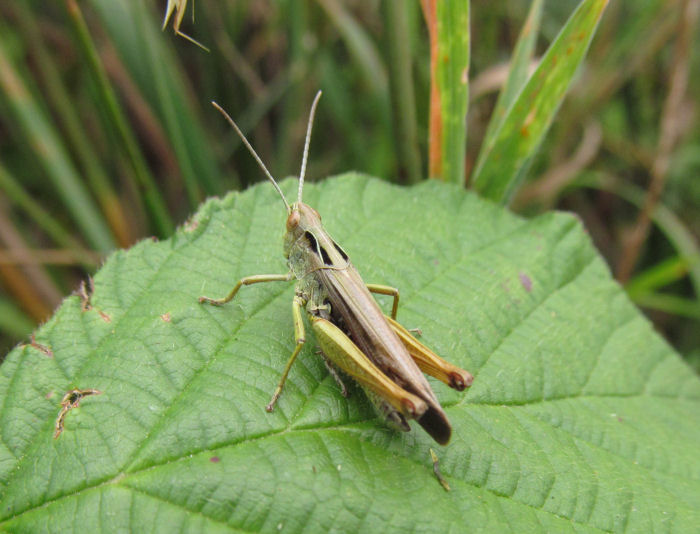
Volunteers worked on many tasks yesterday and the variety of jobs continued today, bird ringing, identifying moths, meeting and greeting visitors, making tea, washing up, checking and repairing nest boxes and checking the orchards. Many, many thanks to everyone who helped.
From Water Voles to Sharks
Tuesday, August 13th 2013
Pruning, strimming, filing, weeding and checking cattle were some of the tasks for team Tuesday. Twenty volunteers lent a hand to keep their favourite nature reserve ticking over and looking good for visitors. After mowing the lawn John carried out the butterfly transect and found many species still on the wing. He noted that Speckled Wood are down on numbers compared to last year when they were seen in their hundreds. A highlight of his survey today was an unusual sighting (for the time of year) of a female Common Blue.
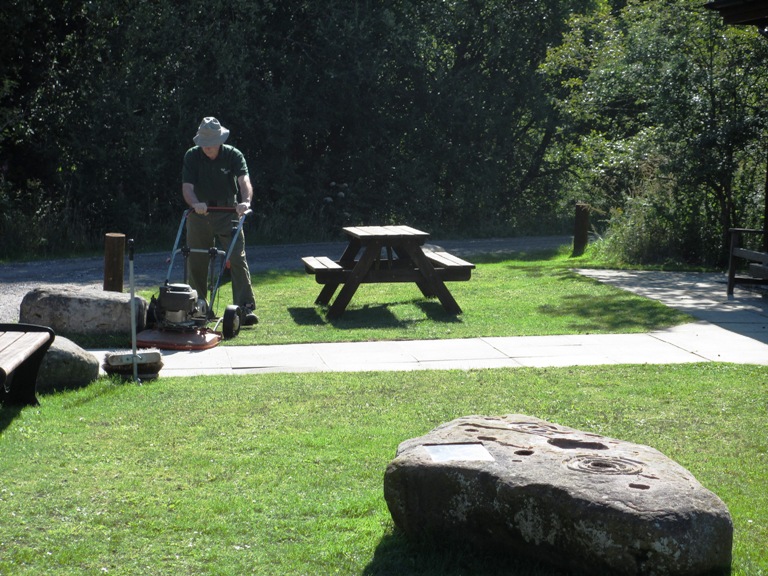
Several people worked hard in one of the ponds to remove non-native pond weed. Jude was very much thrown in 'at the deep end' with the only pair of waders.
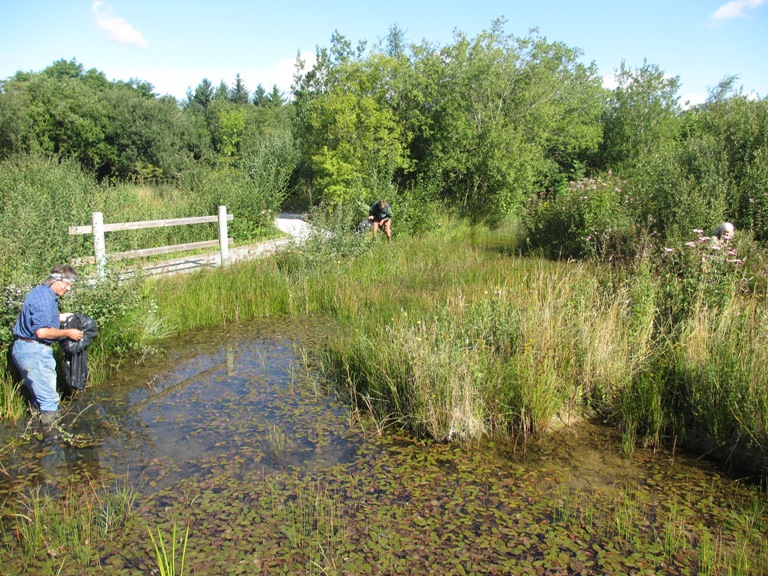
The dams that create ponds which are very popular with Water Voles were repaired.

The 'Voley ponds' as they are known to volunteers have now been re-named as the 'Sharky ponds'!

The water was building nicely behind the new feature dam by the end of the afternoon and only time will tell if the new structure has the desired effect. Watch this space!
Turning of the year
Sunday, August 11th 2013
“We'll soon be ringing Bramblings (winter migrants) again!” was the comment in the ringing room yesterday. High summer is heading to late summer. Last year it was wet and it was noticeable around the reserve how the plants had suffered over the summer. The crab apple tree near the Scrapes did not have a single apple on it, this year it is covered. These apples will feed many insects and birds over the coming months.

Hazel trees have tiny red female flowers and judging by the Hazel nut crop the trees must have been covered with them in the spring! Squirrels, mice and voles will enjoy feeding on them and leaving the empty shells scattered on the ground.

Although many plants are producing their fruits and seeds some flowers are only just beginning to bloom. Devil's Bit Scabious is a beautiful flower and provides food for bees, wasps and butterflies.
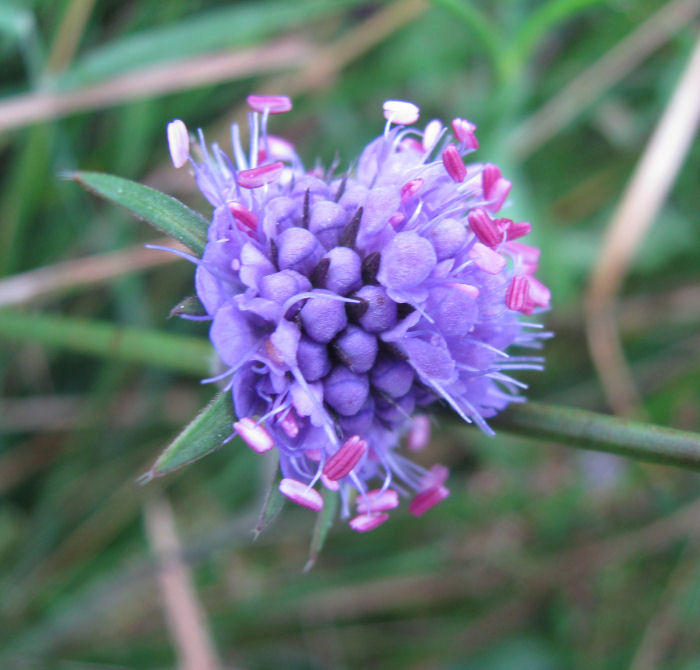
Purple Loosestrife is flowering in the Scrapes and makes a pink/purple splash of colour amongst the reeds.
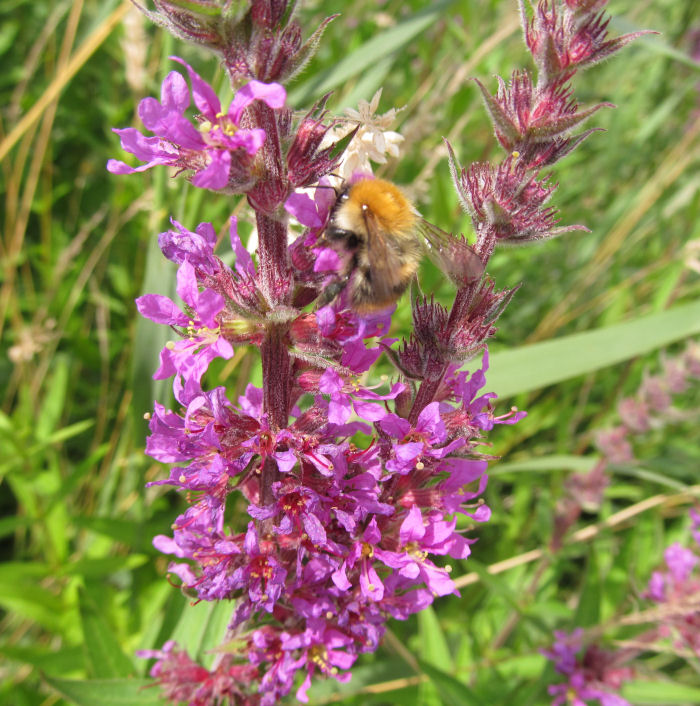
Bird Ringing - CES 10
Sunday, August 11th 2013
On Friday, staff and volunteers went off site to ring a family of Mute Swans. The adults had been ringed previously and using the BTO data base, we found that one of them had been processed at Thorpe Perrow, 16 years ago. The three cygnets were rounded up and given their own unique ring and identification number.

Once all the swans had been checked and ringed they were released.

Volunteering involves so many different aspects, but each one is vital to Foxglove and ensures that the reserve is always well looked after and ready for visitors and the activities that take place. Staff and volunteers have worked hard over the last week or so to get net rides and paths ready for CES10. They looked magnificent!! Many, many thanks to everyone involved in this. Due to a poor forecast for Sunday bird ringing took place today, starting at 0445.
The early net rounds returned many birds. Adam 1 is very good at bringing back some of the more unusual species and his first was a Sparrowhawk. Its sharp claws are essential for catching prey, so it had to be held carefully to avoid damage to the bird ringer! Tony explained to Michaela how to hold the bird safely. It was ringed last year as a juvenile and was going through its moult to adult plumage.
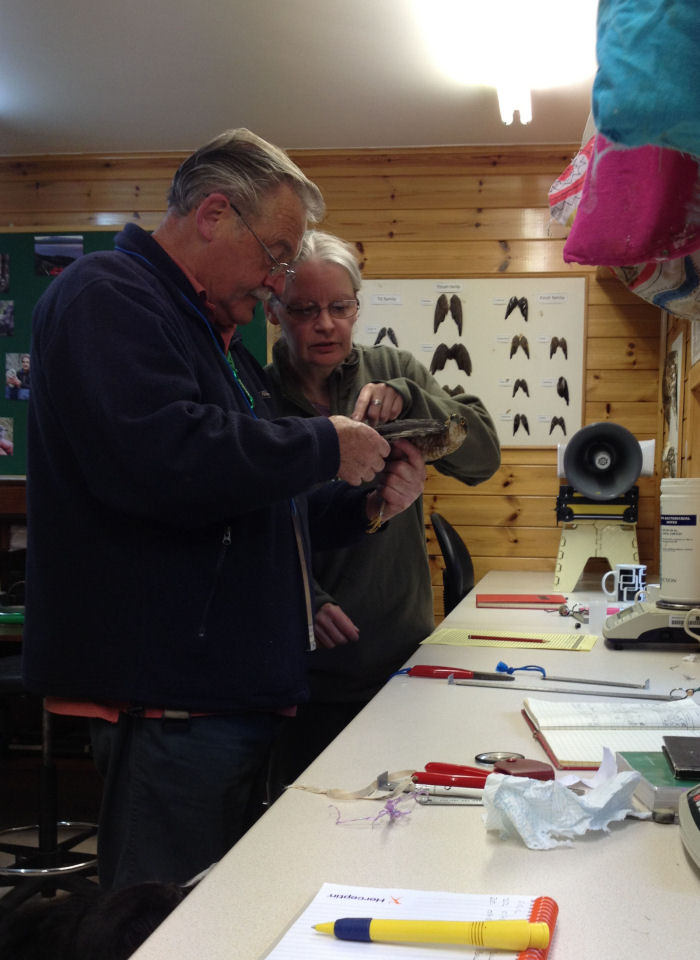
Adam's second special bird was a Kingfisher, caught near the weir. If you visit the hide at the lake, keep a look out for a brilliant flash of blue as these birds return to feed. They are often seen sitting on the green rails in front of the hide. The bird today was a stunning male ringed initially last year.

The ringers were kept busy with net rounds, processing birds and talking to the many visitors who came into the ringing room. It was a very busy day with 20 species ringed including an amazing 56 Bullfinches, 60 Chaffinches, 11 Siskin and 11 Chiffchaff. Towards the end of the afternoon some children returned and were allowed, under supervision to release some of the birds. Tony explained why the birds were ringed and how to hold them and let them go. He also gave pointers for identifying the birds.

While the nets were taken down the bird bags were cleaned and counted and the support team were ready to tidy up the ringing room.
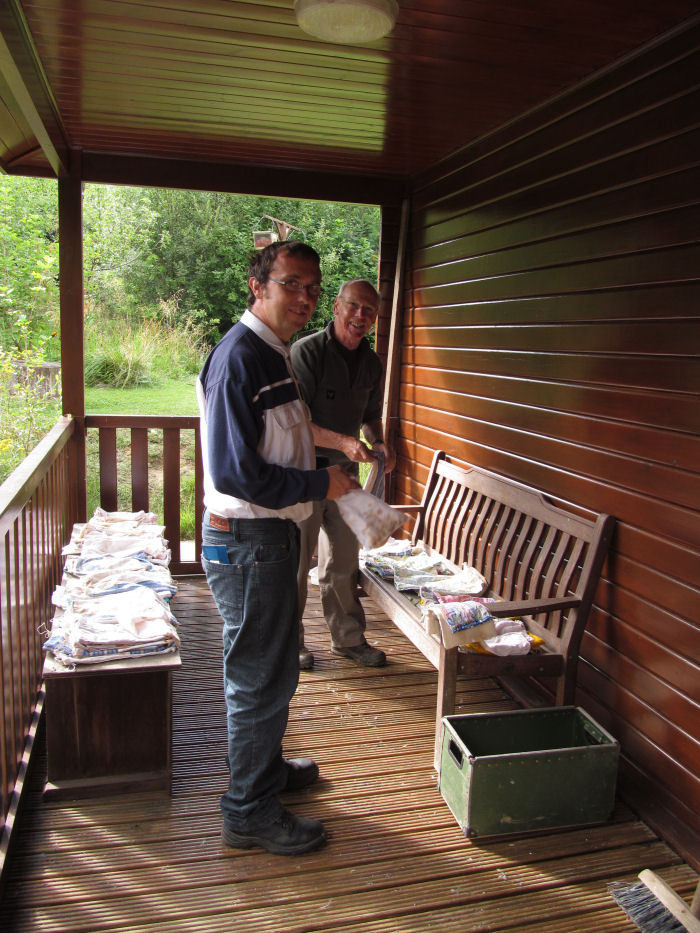
By the end of the ten and a half hour session 273 birds had been processed, 204 of them new.
Thank you to everyone involved today.
A Busy Day at Foxglove
Thursday, August 8th 2013
As has been said many times before volunteering at Foxglove covers a whole range of activities. Today Tony and Mike attacked the back garden, much to the disappointment of the Pheasants who were unable to find much seed on the ground. It looks great! After this, they helped to cut, strim, and rake the net rides.

Glennis, Joan, Brian and Linda identified the moths. This caddis fly was also caught and was very co-operative in hanging around to be photographed.

Ruth and Linda continued the task of sorting and naming the photographs that are used for displays. Colin brought in the wormery he is making for Foxglove. Many visitors were greeted and made welcome. The first of the August Antics took place and over 20 adults and children enjoyed pond dipping. Many snails and sticklebacks were caught, along with Freswater Shrimps, water boatmen and a dragonfly larva.
In the afternoon, Ann, Caroline, Brian, Linda, Ruth and Elizabeth set off to identify ferns. Using the information given by the fern experts on the Bioblitz weekend the different ferns were examined. Books, notes and hand lens were all needed. We think, hope, possibly, perhaps, have them all sorted now!!

And finally, late in the afternoon, time to walk around and enjoy the many butterflies and bees feasting from all the flowers. Peacock Butterflies can still be seen in large numbers. This one was feeding from the Hemp Agrimony.

The heath is turning purple as the Heather begins to bloom and the bees are busy searching for nectar.
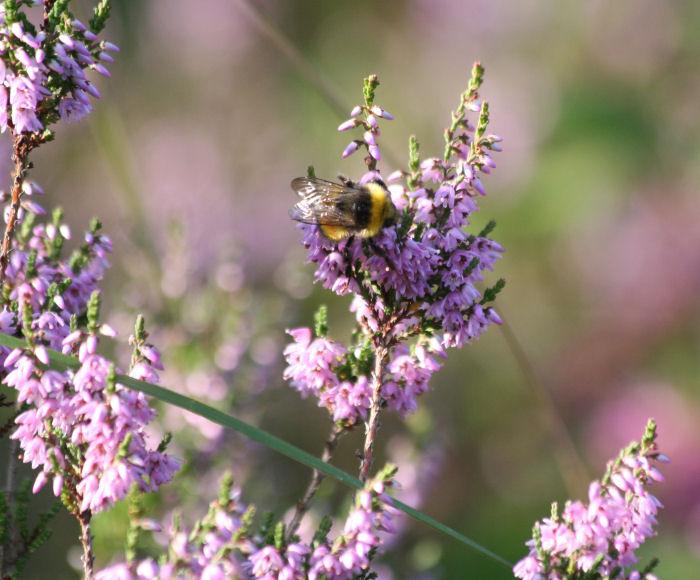
A huge thank you to all the volunteers today who helped in so many different ways.
The Spice of Life
Tuesday, August 6th 2013
Excellent growing conditions this summer have encouraged Bracken to take over some areas of the reserve. A main task for the Tuesday team of volunteers was to clear this invasive plant from a wildflower bank.

With a wide range of hand tools the group members set to work and in no time at all the boardwalk was buried beneath a mountain of cut stems. Our apologies to Glennis and Millie who had to find an alternative route for their walk!

Ton sacks provided the most efficient way of transporting the cuttings. During the day over 50 were filled.
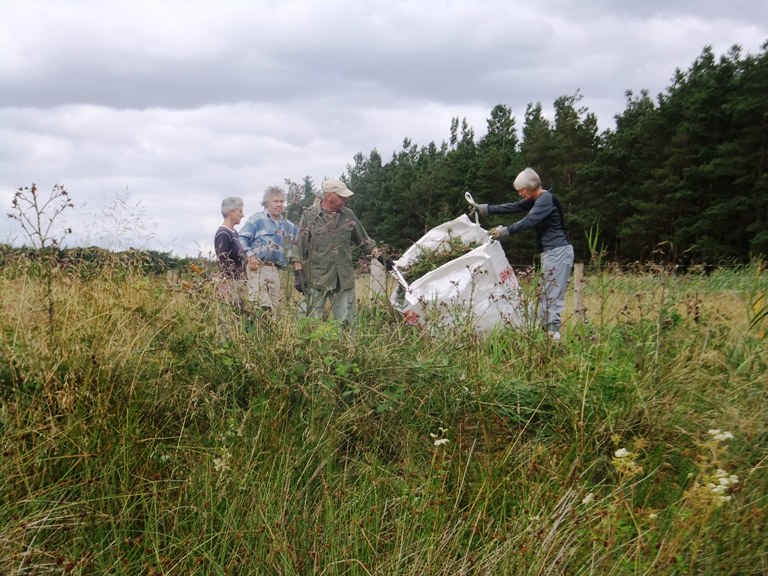
A well earned tea break at mid morning was most welcome and made special by Ann's amazing baking. 'Spice of Life' traybake and lemon cake provided plenty of energy for the afternoon's work.

The bank was soon cleared and once again the light can reach the ground for the wildflowers to thrive.

The warm weather meant that lunch could be 'al fresco'.

The team also cleared a lot of Gorse from around the wetland hide and eventually by late afternoon everyone ended up at the same spot!
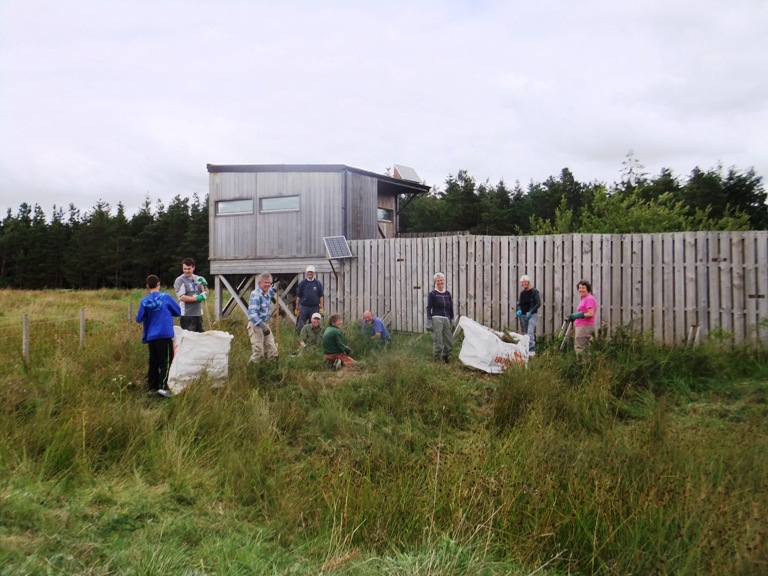
A Great Crested Newt was discovered and the reeds are teeming with day-flying moths and dragonflies (especially Common Darters). House Martins were seen throughout the day feeding over the wetland pools and moorhen were spotted. Water voles were heard splashing into the water too.

Volunteers also carried out the butterfly transect and weighed out seed for the shop. Muchísimas gracias a todos los que vinieron!
Third Willowherb to the Right!
Sunday, August 4th 2013
Our Dragonfly Safari took place this morning and we hoped to see several species of both dragonflies and damselflies around Rabbit Wood out on the training area. Unfortunately the wind had not looked at our events page and it was almost blowing a gale! Not good for any flying insects. The bees were hanging onto thistle flowers, butterflies were sitting low in the vegetation and very few damselflies were daring to take to the wing! Even birds were struggling to fly.
We visited Willmire Crater next and fared little better.

Weather permitting we will be back there towards the end of the month to ring the Meadow Pipits who flock there to feed. Some were seen flying.
Our final stop was much more shelterd and in the sunny less windy places darters and some dragonflies were seen flying. One eventually settled, a Southern Hawker. However trying to pinpoint its exact position lent itself to many excellent directions! 'Stand here, look up the path, just to the right.' 'Look half way up the path, past the tree on the left and look right, and down a bit.' And finally 'Move this way, look up the path, third willowherb to the right.'
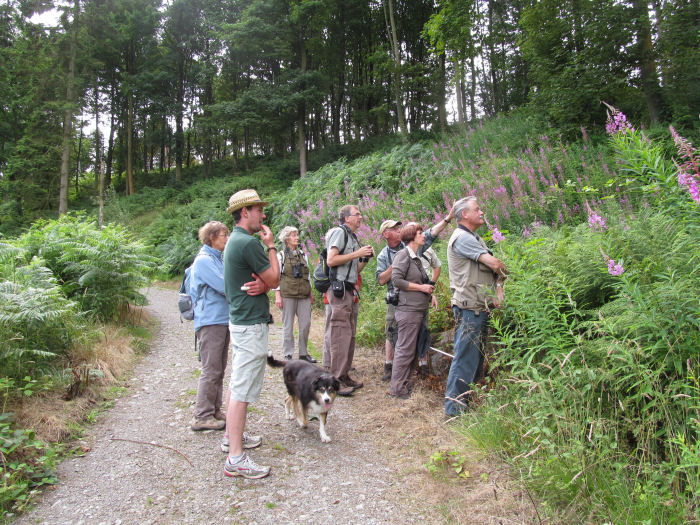
The next job was to try to get a photograph. Height was important, Elizabeth was just too small! So this is the photo that Adam took. Thank you.
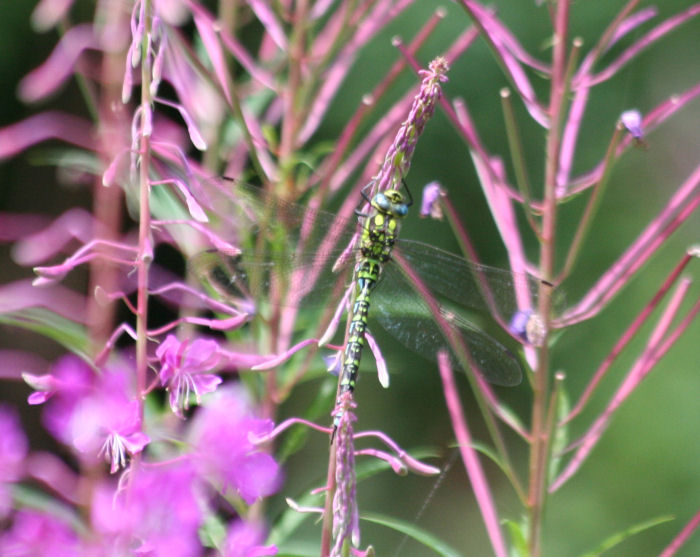
Thank you to Keith and June for sharing their knowledge throughout our walk. Thanks also to Tony and Adam for ensuring that we visited the different sites without getting lost.
Unobservant?
Saturday, August 3rd 2013
As has already been reported the flower walk recorded many species but failed to find Weld and Wild Parsnip. Today out for a walk it was spotted. Now you may think that Weld is a tiny flower and we could be excused for missing it, but as you can see from the photograph below, unfortunately it is not small and we just plain missed it on Wednesday!! Could it have grown since then?

Wild Parsnip was not found - yet!
This Small Tortoiseshell, looking in pristine condition, was feeding from Fleabane, which is beginning to flower throughout the Scrapes.

There were at least eight Peacock Butterflies in the same area, but a good photograph was not possible until one was spotted on the Buddleia.

A final walk around this evening, head down, hunting for insects, bees, butterflies, flowers, moths and wasps, a Heron standing in the second pond dipping platform pond was nearly missed! His hunting was disturbed!

Dam Repairs
Thursday, August 1st 2013
With so much use over the past few years the sluice gates to the dams at the outdoor classroom were in need of a touch of TLC. The rubber seals that hold the water back were torn and cracked. Jacky and Ross spent their day here taking these apart so new strips of rubber could be attached. Once the job was finished we had to test them out and soon were joined in the water by some of the many children visiting during the summer holidays.
With the warm weather hundreds of butterflies and dragonflies are on the wing, with the sound of grasshoppers and crickets chirping away amongst the long grass. Wild raspberries are showing vivid pink as they ripen around the reserve, while cherries, apples, and plums are all starting to ripen on the newly planted fruit trees in our orchard areas.
The Unexpected
Thursday, August 1st 2013
The last day of the month saw the flower walk being carried out. The Scrapes was the starting point and not far along the boardwalk a flower had to be checked.
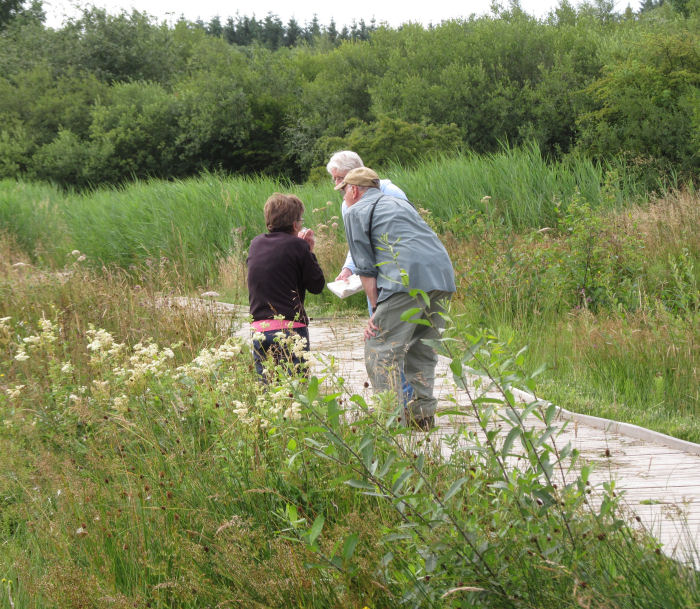
Flowers are still bursting their buds and Fleabane, Gipsywort and Hemp Agrimony were added to the list today. A total of 48 different species of flower was found in the Scrapes area. The walk continued to the Obstacle Course path where Red Bartsia was growing. Many flower heads of Ragwort were seen, several sporting their black and yellow companions - the Cinnabar Moth caterpillar. Bees were also feeding from these flowers and this one, rather large, did not take kindly to the camera so close, so a middle leg warning!
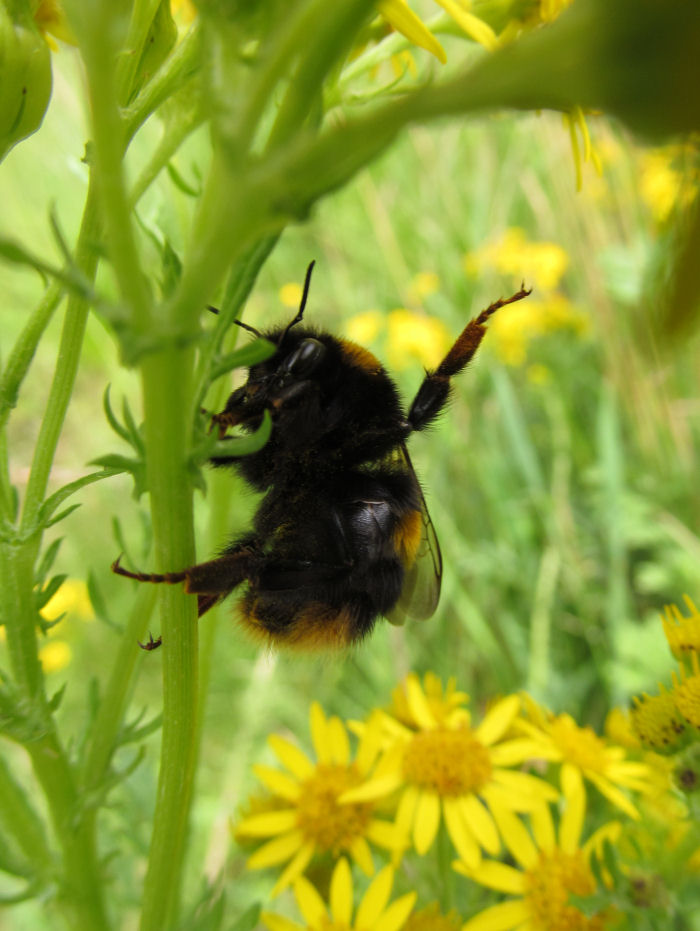
Last year Weld and Wild Parsnip grew in this area but close inspection revealed not a single flower head. Too early? By the Bullet Catcher pond yet more discussion over Hogweed and Angelica took place. This is the only area on the reserve where Hogweed can be found.
Walking through the tall undergrowth a butterfly was spotted - Small Tortoiseshell. Then it flew back again and landed, so a closer look was possible. No, not a tortoiseshell but a Painted Lady. Enthusiasm had to be curbed until a positive ID was confirmed, over a cup of tea, back at the Field Centre.
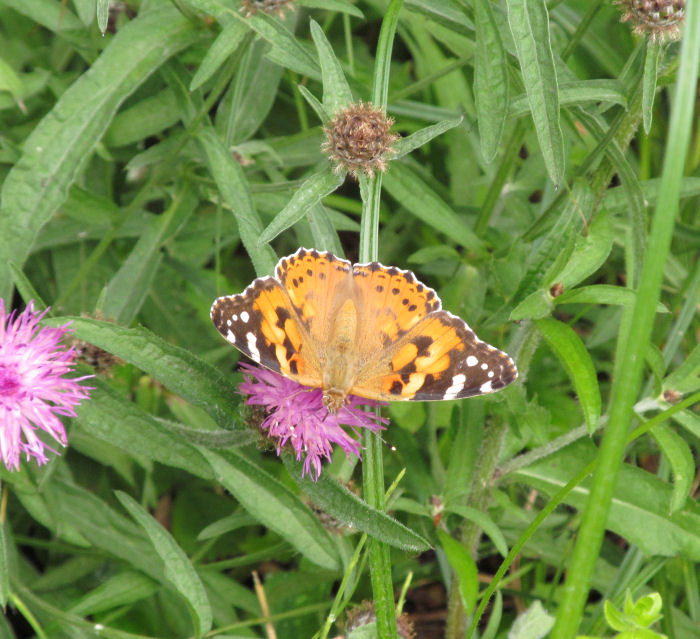
Yet more unexpected sightings included Pepper Saxifrage growing along the access road, a Dryad's Saddle which is still growing and a very large queen White Tailed Bumble Bee. And finally the Cotton Grass in the Scrapes is over, so had not made it onto today's list. However on the wetland it was still in flower.
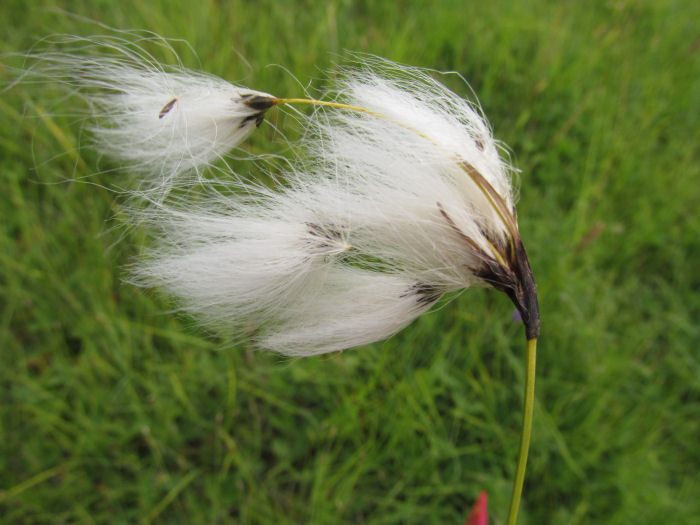
Thank you to all the volunteers who carried out a variety of tasks today including the flower walk, identifying over 30 species of moth, raked some of the meadows and oiled the mist net poles (the bird ringers will be very grateful for this).

.JPG)

.JPG)



.JPG)



.JPG)

